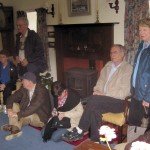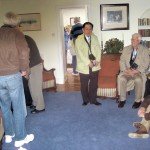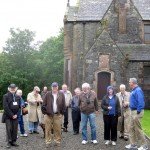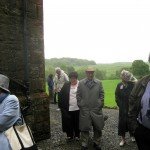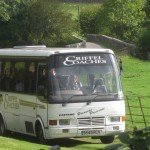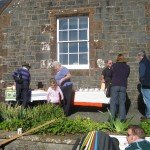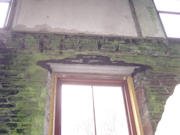Jim Rautio, President of Sonnet Software, talks about the lightning rod from Glenlair House, the former home of James Clerk Maxwell
May 23
Visit by IEEE Members
On a wet and windy day 26 members of the IEEE braved the elements to visit Glenlair. After an early start from Edinburgh, they arrived at Glenlair around 1020 where they were greeted by the Fergusons and led inside Glenlair Lodge (the old servants quarters) where they were delighted to be offered tea, coffee and delicious freshly baked scones! Duncan then split the group in two and gave each in turn a tour of Glenlair House and the Visitors Centre, although sadly because of the weather conditions, a more extended tour of the gardens and farmyard was not possible. They departed just after midday to take lunch at Threave Gardens, a National Trust property near Castle Douglas. The remaining 24 members of the tour were due to arrive at Glenlair at 3 pm, but force majeure prevailed and they were forced to abandon the visit because the main road from New Lanark was blocked with fallen trees.
- Refreshments
- Braving the Elements
Dec 16
STARS: Maxwell’s Equations
Maxwell’s Equations provide a complete description of electromagnetic phenomena and underpin all modern information and communication technologies. They are named after James Clerk Maxwell, the Scottish physicist whose pioneering work during the second half of the 19th century unified the theories of electricity, magnetism, and light. The theory of electromagnetism was built on the discoveries and advances of many scientists and engineers, but the pivotal contribution was that of Maxwell. Today, Maxwell’s Equations are the essential tools of electrical engineers in the design all types of electrical and electronic equipment.
Sep 25
Doors Open Days 2010
For the second year running Glenlair opened its doors to the public as part of the European Heritage Days programme (www.doorsopendays.org.uk). This provides an excellent opportunity not only to show what has been achieved here, but also to spread the word about James Clerk Maxwell to a wider audience not necessarily aware of his immense contribution to many of the things we take for granted in our modern sophisticated world. This year we were blessed with two glorious sunny days and visitor numbers swelled to an amazing 131 a 50% increase on last year. In addition to a 45-minute talk and tour by Duncan, tea and cakes were served and these together with the proceeds of a second hand bookstall helped us raise £321 for a local diabetes charity.
The visitor centre is now up and running with copies of pictures by Jemima Wedderburn, photos of Glenlair House through the ages together with a continuously running photo frame of work on the house and large files of papers and publications relating to Maxwell. Again as with last year, there was a lot of interest in the farm steading, especially now that the old stable for four carriage/shire horses has been cleared and an annotated collection of old tools including a butter churn put on display.
- A coach load of visitors arrives at Glenlair
- Pay attention there! Duncan addresses a tour party
- Anyone for tea?
Jan 12
The Last Lintel
With snow lying and permafrost deep into the ground, Joe Smith felt that it was an ideal opportunity to replace the missing lintel above the large south-facing window in the west wing, which has been supported by one of my acro-props since the middle of last year. His reasoning, sound as ever, was that the frost would hold the stones in place above the window, whilst he inserted a couple of concrete lintels. He duly arrived at 10 am in his Land Rover, complete with a trailer load of scaffolding, cement and a bag of sand warmed beside his fire overnight and accompanied by his trusty helper, Norman. By 1115, he was shouting for two 7-foot lintels and I was slipping and sliding down the front road in my Land Rover to collect a pair from Castle Douglas. Back by noon, lintels duly delivered and the job complete, equipment stowed and Joe departed at 4.45 pm! Not a bad days work at all.

